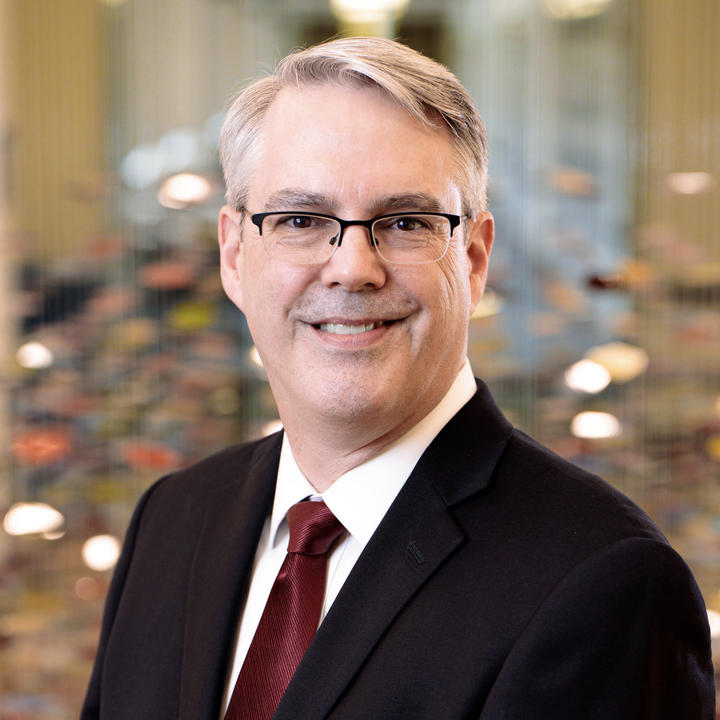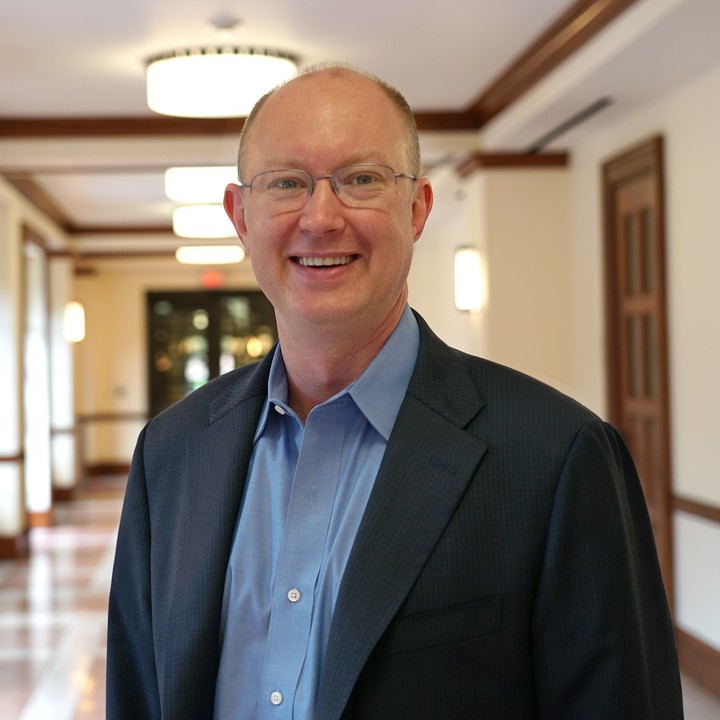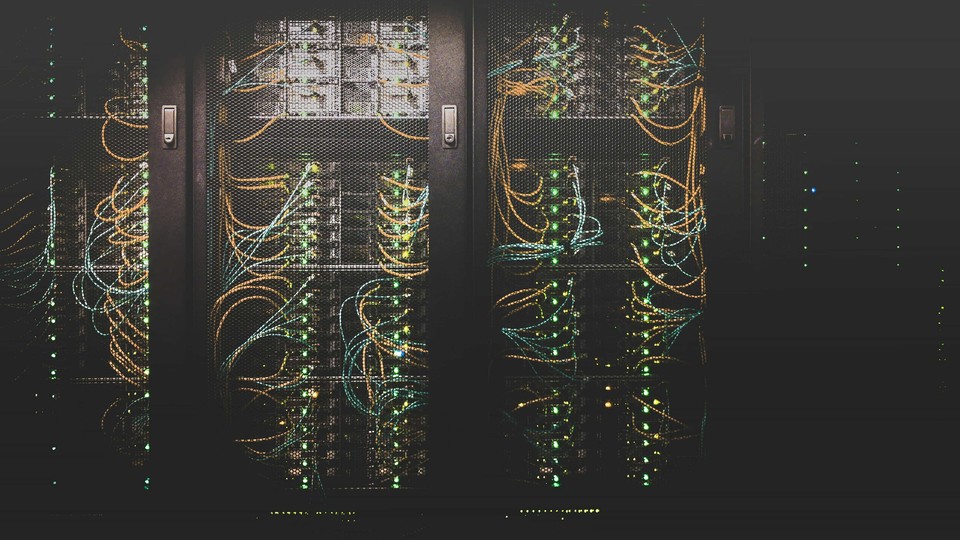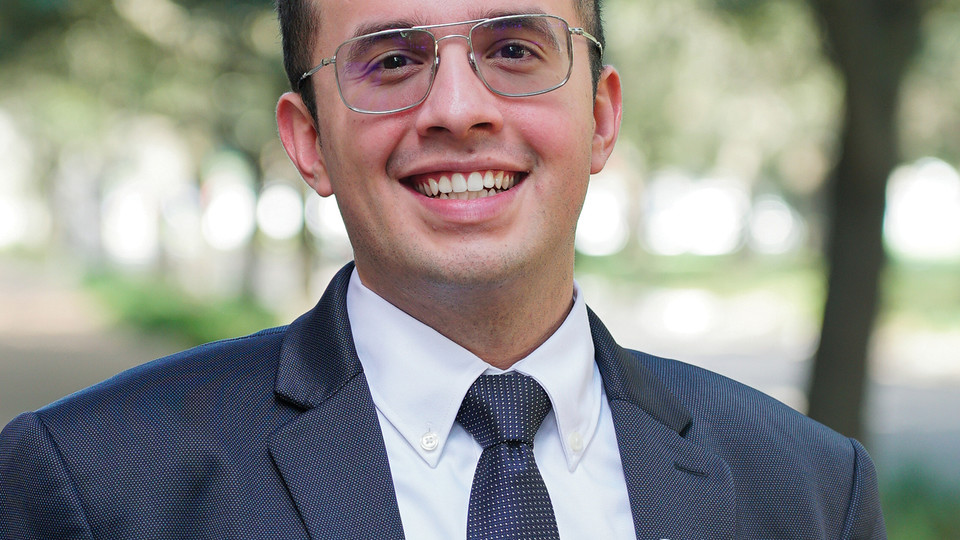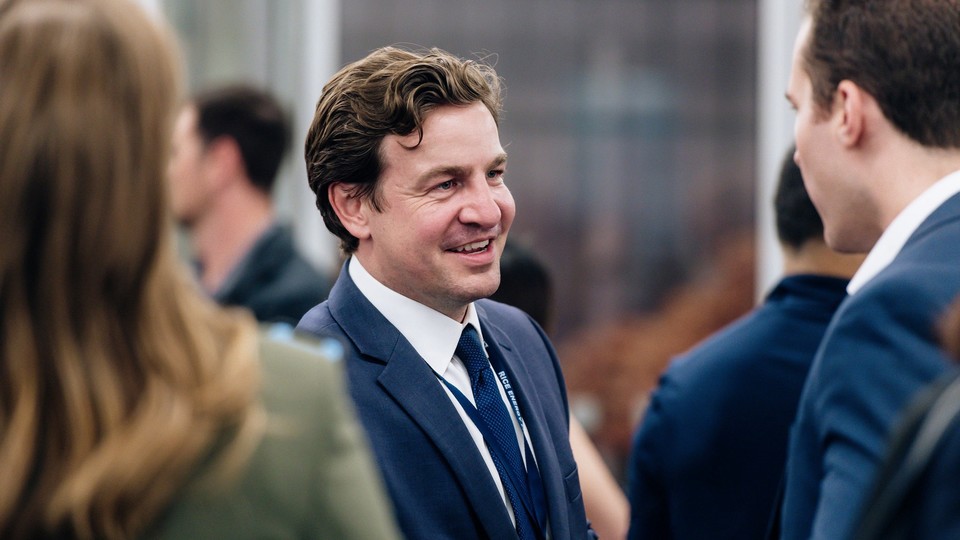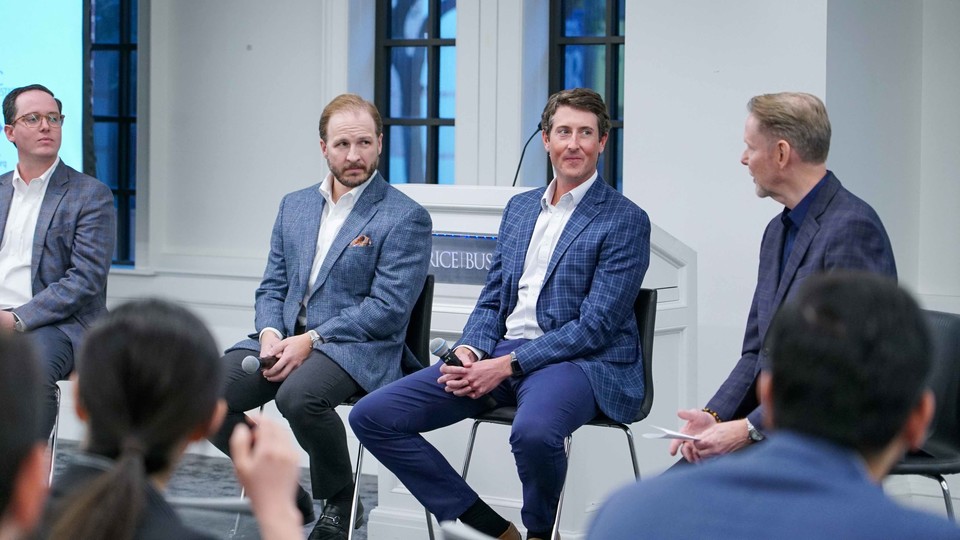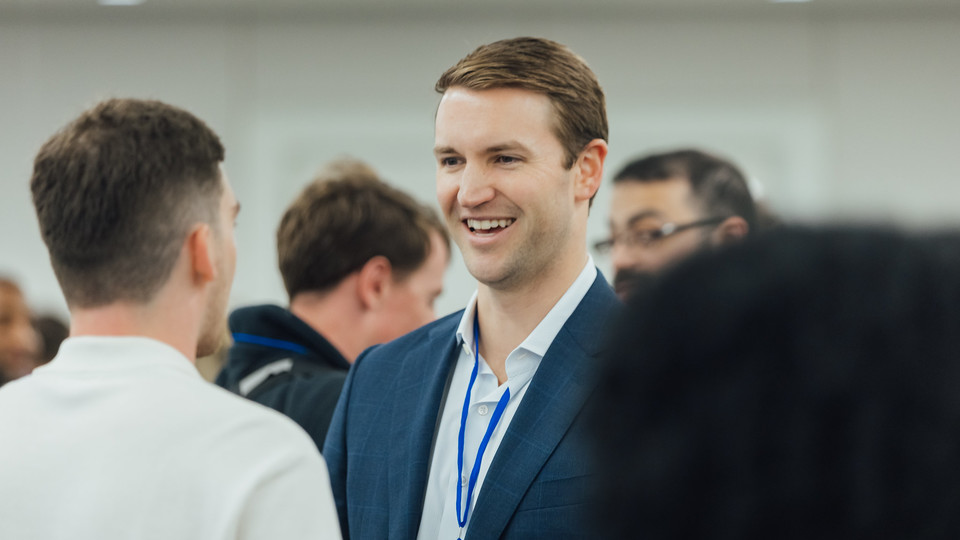The Rigor and Relevance of Science-Funding Decisions
If we want to treat diseases, improve AI, and push the boundaries of discovery, stable investment in research is not just important—it’s essential.

Rice Business Wisdom: Hidden inequality exists in auto lending
Rice Business research shows that each year, an estimated 80,000 auto loan applications in the U.S. are denied to minority borrowers due to racial bias.


For millions of Americans, cars aren’t just a fun way to get around — they’re a necessity. They provide access to jobs, schools and essential services. They help build financial independence and unlock opportunities that would otherwise be out of reach.
Yet for many minority borrowers, the road to an auto loan is often littered with hidden costs. According to research published in The Review of Financial Studies, an estimated 80,000 auto loans are denied each year in the U.S. based on racial bias.
In their study, Rice University’s Alex Butler and James Weston uncover troubling inequalities in America’s auto loan market. Using a dataset that spans over a decade, the experts at Rice’s Jones Graduate School of Business find that Black and Hispanic borrowers face higher rejection rates and steeper borrowing costs than white borrowers, even when they have comparable credit profiles.
A closer look at racial bias in auto lending
Auto loans are the most widely used form of installment credit in the U.S. with more than 100 million borrowers as of 2017. Unlike mortgages and student loans that operate under stricter regulations, the auto loan market is relatively obscure, shaped by personal interactions between lenders and borrowers. This absence of oversight creates an environment where bias can thrive.
The study considers multiple explanations for the observed disparities such as differences in borrower behavior or creditworthiness. But the results show that minority borrowers are 1.5% more likely to be denied an auto loan than white borrowers with similar financial characteristics. Among subprime applicants where creditworthiness is already marginal, this gap grows to 2.4%.
Even when minority borrowers secure loans, they face an additional financial penalty. The study reveals that Black and Hispanic borrowers pay 0.7% more in interest rates than white borrowers. For the average minority borrower, this translates to an extra $410 in present value terms over the life of the loan. In states where racial bias is more pronounced, this gap widens even further — to 1.25%.
Weston emphasizes the broader implications: “This isn’t just about a few thousand dollars here and there — it’s about access to opportunity. The disparities we found in the auto loan market are another roadblock for minority borrowers trying to build a better future.”
A unique dataset
Auto lending is unique from other markets like credit cards, where decisions are mostly automated and leave little room for human bias. For borrowers seeking to secure auto financing, personal interactions are more likely to create unequal outcomes.
To uncover these disparities, the research team (which included Erik J. Mayer ’18, a Rice Business doctoral graduate) linked credit bureau records with demographic data from the Home Mortgage Disclosure Act of 1975, allowing them to examine borrower financial characteristics alongside race and ethnicity. What they found provided a uniquely detailed view of auto lending outcomes.
After accounting for factors like credit scores, income, debt-to-income ratios and ZIP codes, the researchers concluded that racial bias — not differences in financial health — drives the disparities in auto lending. Even more striking, the study found that Black and Hispanic borrowers are actually less likely to default on their loans than white borrowers with similar financial profiles despite facing higher costs and stricter approval standards.
“We wanted to move beyond anecdotal evidence and create a dataset that could definitively measure disparities in auto lending,” says Butler, the Jesse H. Jones Professor of Finance at Rice. “By combining credit bureau and mortgage data, we were able to uncover patterns that hadn’t been documented before — and the results were troubling.”
The road ahead
The study highlights how government rules can help reduce racial bias on auto lending. In 2013, the Consumer Financial Protection Bureau created policies to fight racial discrimination in auto lending. During that time, the difference in interest rates between white and minority borrowers dropped by 60%. But those policies were rolled back in 2018, raising concerns about whether the progress would last.
Questions remain about the long-term impact of these disparities and how they can be addressed through better policy or innovative lending practices. “Our study shows this problem isn’t inevitable — it can be addressed,” says Weston. “The challenge is sustaining the kinds of oversight and accountability that can make lending markets fairer for everyone.”
Weston, senior associate dean for degree programs and the Harmon Whittington Professor of Finance, will be the featured speaker at the upcoming “Owl Have You Know Podcast” live event at 5:30 p.m. March 4. The evening of insights, stories and inspiration will be held in the Anderson Family Commons at Rice’s McNair Hall.
Based on research published in The Review of Financial Studies by Butler, Weston and Mayer (University of Wisconsin): “Racial Disparities in the Auto Loan Market,” this article originally appeared in Rice Business Wisdom.
You May Also Like
OMBA Ranking 2025: GMAT, GRE, GPA, & More Data From Top Online MBA Programs
While a strong test score is very often still a marker of a strong application at full-time MBAs, online programs increasingly offer generous test waivers, allowing students to forgo the GMAT or GRE in lieu of work experience or strong academic credentials.

The Hidden Inequality in Auto Lending
Each year, an estimated 80,000 auto loan applications in the U.S. are denied to minority borrowers due to racial bias.


Based on research by Alexander Butler (Rice Business), James Weston (Rice Business) and Erik J. Mayer (Ph.D. ’18, University of Wisconsin)
Key findings
Black and Hispanic borrowers are 1.5 percentage points more likely to be denied auto loans than white borrowers with similar financial profiles.
Among subprime borrowers, this disparity increases to 2.4 percentage points, preventing an estimated 80,000 minority applicants from securing loans annually.
Despite facing higher costs and stricter approval standards, Black and Hispanic borrowers default on auto loans less frequently than white borrowers with comparable credit profiles.
For millions of Americans, access to a car underwrites everyday routines — getting to work, taking kids to school, running basic errands.
Yet for many minority borrowers, the road to an auto loan is often littered with hidden costs. According to groundbreaking research published in The Review of Financial Studies, an estimated 80,000 auto loans are denied each year based on racial bias.
In their study, Rice Business professors Alex Butler and James Weston uncover troubling inequalities in America’s auto loan market. Using a dataset that spans over a decade, they find that Black and Hispanic borrowers face higher rejection rates and steeper borrowing costs than white borrowers, even when they have comparable credit profiles.
A Closer Look at Racial Bias in Auto Lending
Auto loans are the most widely used form of installment credit in the United States, with more than 100 million borrowers as of 2017. Unlike mortgages and student loans, which operate under stricter regulations, the auto loan market is relatively obscure, shaped by personal interactions between lenders and borrowers. This absence of oversight creates an environment where bias can thrive.
The study considers multiple explanations for the observed disparities, such as differences in borrower behavior or creditworthiness. But the results show that minority borrowers are 1.5 percentage points more likely to be denied an auto loan than white borrowers with similar financial characteristics. Among subprime applicants, where creditworthiness is already marginal, this gap grows to 2.4 percentage points.
Even when minority borrowers secure loans, they face an additional financial penalty. The study reveals that Black and Hispanic borrowers pay 0.7% more in interest rates than white borrowers. For the average minority borrower, this translates to an extra $410 in present value terms over the life of the loan. In states where racial bias is more pronounced, this gap widens even further — to 1.25%.
Weston emphasizes the broader implications: “This isn’t just about a few thousand dollars here and there — it’s about access to opportunity. The disparities we found in the auto loan market are another roadblock for minority borrowers trying to build a better future.”
A Unique Dataset
Auto lending is unique from other markets, like credit cards, where decisions are mostly automated and leave little room for human bias. For borrowers seeking to secure auto financing, personal interactions are more likely to create unequal outcomes.
“This isn’t just about a few thousand dollars here and there — it’s about access to opportunity. The disparities we found in the auto loan market are another roadblock for minority borrowers trying to build a better future.”
To uncover these disparities, the research team (which included Erik J. Mayer — Rice Business Ph.D. ’18) linked credit bureau records with demographic data from the Home Mortgage Disclosure Act (1975), allowing them to examine borrower financial characteristics alongside race and ethnicity. What they found provided a uniquely detailed view of auto lending outcomes.
After accounting for factors like credit scores, income, debt-to-income ratios and ZIP codes, the researchers concluded that racial bias — not differences in financial health — drives the disparities in auto lending. Even more striking, the study found that Black and Hispanic borrowers, despite facing higher costs and stricter approval standards, are actually less likely to default on their loans than white borrowers with similar financial profiles.
“We wanted to move beyond anecdotal evidence and create a dataset that could definitively measure disparities in auto lending,” says Butler. “By combining credit bureau and mortgage data, we were able to uncover patterns that hadn’t been documented before — and the results were troubling.”
The Road Ahead
The study highlights how government rules can help reduce racial bias on auto lending. In 2013, the Consumer Financial Protection Bureau (CFPB) created policies to fight racial discrimination in auto lending. During that time, the difference in interest rates between white and minority borrowers dropped by 60%. But those policies were rolled back in 2018, raising concerns about whether the progress would last.
Questions remain about the long-term impact of these disparities and how they can be addressed through better policy or innovative lending practices. “Our study shows this problem isn’t inevitable — it can be addressed,” says Weston. “The challenge is sustaining the kinds of oversight and accountability that can make lending markets fairer for everyone.”
Written by Scott Pett
Butler, Mayer, and Weston (2023). “Racial Disparities in the Auto Loan Market,” The Review of Financial Studies.
Never Miss A Story
You May Also Like
Keep Exploring
Shaping The Future of Energy Infrastructure feat. Andrea Edmundson Bryan ’20
Season 4, Episode 32
Andrea discusses Race Rock's work shaping energy infrastructure, her journey from a liberal arts degree to an MBA at Rice Business and her family’s deep Texas roots.
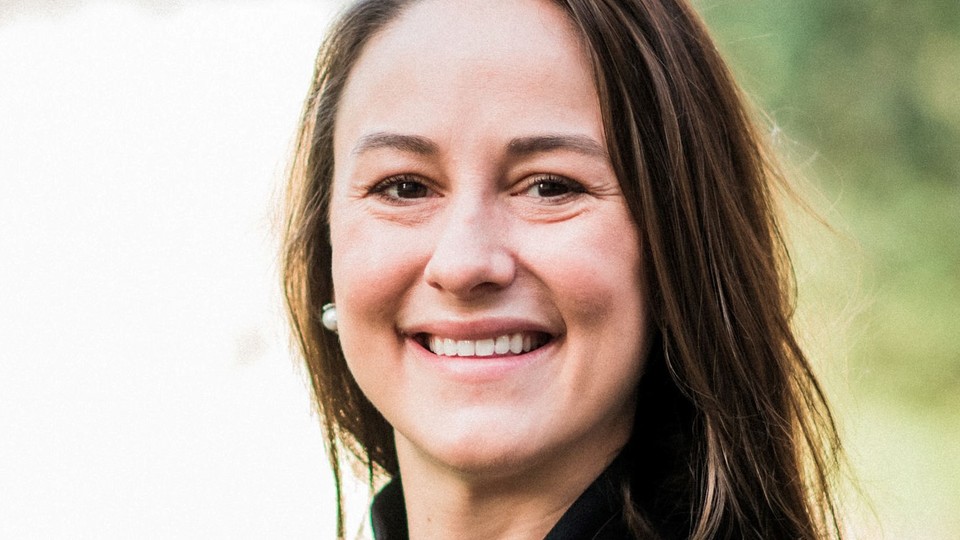
Owl Have You Know
Season 4, Episode 32
Andrea Edmundson Bryan wasn’t exactly sure what she wanted to do with her liberal arts undergrad degree. But one thing she did know? She had a strong curiosity to learn more about the business world.
To Andrea's surprise, this curiosity led her to a career in oil and gas and an MBA at Rice University. Andrea is now the Chief Administrative Officer at Race Rock, a Houston-based manufacturer of critical infrastructure products for the energy sector with a mission to provide safe passage for people and power.
Andrea joins host Maya Pomroy ’22 to chat about Race Rock's diverse work that’s shaping the future of energy infrastructure, her journey from a liberal arts degree from TCU to an MBA at Rice, her family’s deep Texas roots, and the lasting impact her MBA has had on her career and life.
Subscribe to Owl Have You Know on Apple Podcasts, Spotify, Youtube or wherever you find your favorite podcasts.
Episode Transcript
-
[00:00]Maya Pomroy: Welcome to Owl Have You Know, a podcast from Rice Business. This episode is part of our Flight Path Series, where guests share their career journeys, the stories of the Rice connections that got them where they are.
Andrea Edmundson Bryan never expected to find herself leading a firm focused on developing critical infrastructure for the country. The native Houstonian and English major started her career as a Fulbright Fellow, teaching English in Malaysia. Now, the Chief Administrative Officer at Race Rock Infrastructure and the Rice Business Alumni Board member shares her story of how transformational mentors and Rice Business lead her to finding her true passion of leading and preparing our nation for the future in transportation, telecommunications, and energy.
Welcome to Owl Have You Know. I'm your host, Maya Pomroy. Our guest today is Professional MBA from the Class of 2020, Andrea Edmundson Bryan.
Andrea, thank you for joining us today.
[01:00]Andrea Edmundson Bryan: Thank you so much. Happy to be here.
[01:02]Maya Pomroy: So, you were part of that 2020 cohort that never got to walk across the stage.
[01:08]Andrea Edmundson Bryan: We walked. We were just a year later, but we walked later. Yes.
[01:12]Maya Pomroy: Okay, you started at Rice in 2018. Oh, the glory days.
[01:17]Andrea Edmundson Bryan: Yes, exactly.
[01:19]Maya Pomroy: And you are currently the Chief Administrative Officer at Race Rock Infrastructure, which is a leader in the critical infrastructure industry and energy industries. And you've been doing that for quite some time. What drew you to that line of work?
[01:36]Andrea Edmundson Bryan: Well, it’s funny that you asked that, because if you'd asked me that 10 years ago, I would have never said that I would be here. Just by a series of events and, kind of, the path that I went down, I think I really give credit to the individual that I've been working for for the last 10 years, my boss, Donnie Young.
And we started off in oil and gas. I started working with him in 2014. We had a path for five years at a previous company there. And he ultimately sold that business. And when he exited that business, I left with him, which was in between my first and second year at Rice. And we looked around and, kind of, figured out what we wanted to do next. And highway infrastructure, steel manufacturing fell into our lap in November of 2020. And so, that was the first acquisition that we had. And we have just built…we spent the last four years building that business. And so, being in this field is not something that either one of us, I think, sought out, but are thrilled to be in it. It's a great business in the state of Texas and in the United States as a whole, especially right now. So, it’s a great business and the Race Rock is doing extremely well. So, very, very happy and fortunate.
[02:38]Maya Pomroy: Well, we'll talk about Race Rock in just a little bit, but I want to talk about your upbringing and your childhood. So, you were born and raised right here in Houston, Texas.
[02:46]Andrea Edmundson Bryan: Yeah, born and raised Houstonian, very proud Texan. I think I'm a seventh or eighth-generation Texan from family lineage. Yeah, I went to St. Agnes for high school. I went to TCU for undergrad.
[02:58]Maya Pomroy: You were an English major.
[02:59]Andrea Edmundson Bryan: English major, yes, which is, kind of, a unique track. I love telling people this. I'm the middle of three children. My dad's a physician here in Houston and my mom is a nonprofit. And my dad said, “Look, you can go anywhere you want to go. We will support you to do that. But you have one stipulation. You have to have a degree in liberal arts from an undergrad.” And so, my brother, sister, and I all did that, kind of, a different track. You know, you hear a lot of people say you need to go in accounting, finance.
[03:22]Maya Pomroy: Yeah. I'm curious about why. I mean, he's a physician. I was thinking you were going to say, “You gotta be a doctor.”
[03:28]Andrea Edmundson Bryan: No, he said liberal arts and, kind of, really embodied this philosophy that you go to undergrad, you know, college to really learn how to think critically and analyze and read and write, and then go out and get a job, figure out what you really like and specialize. And so, all three of us have done that.
And for a long time, people were like, “An English major, what are you going to do with that? Like, where are you going to end up? You don't want to teach long term or go get a Ph.D.” But it has served me so well, because I think it really did set us up, all three of us and myself, specifically, to think critically and be able to analyze. And I think that, kind of, plays into your original question of how I ended up in infrastructure. You just, kind of, take a path and you learn as you go and think through problems. And, you know, people… early on in my career, a mentor of mine told me, numbers are easy. People are always your problem when it comes to business. I think that translates anywhere. And so, very grateful for the path and having that English undergrad degree.
And then, of course, as you can imagine, going to Rice, it was a feat for me to get through, you know, the rigorous coursework at Rice Business, but I'm so grateful for it. And I think that that English foundation really helped me, kind of, struggle through it efficiently and, ultimately, very successfully.
[04:36]Maya Pomroy: So, you went to TCU.
[04:38]Andrea Edmundson Bryan: I did, go frogs, yes.
[04:39]Maya Pomroy: Yes. Up in Fort Worth. Wonderful town as well. Not knocking Houston, but Fort Worth is really, really thriving. What made you choose TCU?
[04:47]Andrea Edmundson Bryan: Well, it's funny, you know. I really wanted to go to that big university in Austin, but they wouldn't take me. So, TCU, kind of, fell into my lap, but I tell people all the time that I wish my college experience on everyone. I had the best four years in Fort Worth at TCU — socially, academically, culturally, in every area. And it was the best fit. And I, to this day, stay actively involved. I serve on the Board of the Honors College there, go to football games, the whole nine yards. And obviously, having an office and manufacturing facility for Race Rock in Fort Worth is fun. And my husband and I have a house there that we maintain. So, lots of connections to Fort Worth that we hold really special to us.
[05:28]Maya Pomroy: And your husband is also Texan through and through, correct?
[05:32]Andrea Edmundson Bryan: Yes, he is, yeah. Those roots are very, very deep. A seventh, eighth-generation Texan as well. A lot of Texas pride, I think, in the family, for sure.
[05:41]Maya Pomroy: Well, and so, tell me about the Bryan Museum in Galveston, because that is your family's museum.
[05:47]Andrea Edmundson Bryan: Yes, my father-in-law's collection of, you know, basically, the settlement of the West. So, lots of Texas history. And it's a huge collection. I'm biased, but it's phenomenal museum and building and structure. And all the items in the collection are fantastic and phenomenal.
So, we stay involved on a family level, but then on a personal level, you know, being such a proud Texan, it's a fun thing to do and be a part of and support. And our history in the state is rich. I have so much of it. As someone, I spent a year abroad teaching English in Malaysia right after undergrad at TCU. And I was telling someone the other day that there were 50 of us that went from the U.S. to go teach and I was the only Texan in the group.
[06:29]Maya Pomroy: Really?
[06:29]Andrea Edmundson Bryan: And when people asked, you know, where we were from, down to the last person, everyone would say, “Oh, we're from the States.” And I'm the only person that, when asked, every time…
[06:37]Maya Pomroy: “I'm from Texas.”
[06:38]Andrea Edmundson Bryan: “I am from Texas. I am from Texas.” So, you know, bigger, brighter, louder, all the things, but lean into that really hard. And so, the museum has been something really fun to watch. We're about to celebrate the 10-year anniversary in 2025. So, it opened in 2015. Great for all ages, children, all the way up to adults. And there's everything for every need, from an artistic standpoint, you know — documents, saddles, spurs, guns, maps, paintings, videos, dioramas. I mean, the whole thing. It's so interactive and it's phenomenally done. My father-in-law has a huge niche and ability to see things and create these stories. So, it's a beautiful, beautiful collection in a gorgeous building down in Galveston. Yeah.
[07:20]Maya Pomroy: I love that. So, you had mentioned that, after you graduated from TCU as an English major, you went to Malaysia to teach English. So, how old were you? Were you 22 when you decided to do that?
[07:30]Andrea Edmundson Bryan: Yeah, I was 22. Yeah. I went and taught English in Malaysia under the Fulbright scholarship. So, I went through the State Department. And I vividly remember applying for that and thinking going home the day I applied and just weeping in the shower, being like, “What have I done? Like, if I am so fortunate enough to receive this, like, you don't turn this down.” And I have no idea where Malaysia is, really, on a map. Like, I will know no one. I'm terrified. And it was a profound moment for me that I've, like, “Okay, this is a big deal. Like, you're adulting, really. Like, you're going to graduate college and potentially go somewhere.”
[08:05]Maya Pomroy: To the opposite side of the planet.
[08:08]Andrea Edmundson Bryan: Literally, like, that's what I would tell my students, like, “Here's a globe. Here's Houston. Go to the other side. And that's Malaysia, you know, 24 hours to get there.” But spent a year, was fortunate enough to be given a spot, and spent a year teaching high school English in a very, very rural town, about an hour north of Singapore. So, I was in the Southern part of Malaysia and traveled all over Southeast Asia, got down to Australia. It was an adventure of a lifetime. And I think really, kind of, again, foundational roots on, you know, pick yourself up by your bootstraps and figure things out and think through problems. And how do you eat an elephant? One bite at a time. And so, after, you know, 10 months, looking back, it was a transformative year in my life that I will forever be grateful for.
[08:51]Maya Pomroy: So, tell me some of the most profound things that you learned from that experience. I know that it's really hard to condense something like that, but if you were to write a book and there was a chapter about this experience that you had. And how many total scholars were invited to go?
[09:10]Andrea Edmundson Bryan: Fifty. So, the program I had initially applied, because there were only 15 spots and about, historically, 30 applicants. So, I was like, “Oh, the odds are in my favor here.” Like, you know, it's one of the smaller kind of cohorts. And the year I was granted a spot, the Malaysian government infused a lot more money into the program. And so, our program went from 15 to 50. So, we were, kind of, a guinea pig year in that capacity.
But there were challenges. And so, there were days, for sure, I would be lying, if I said there weren't days being like, “Can I do this? Like, I'm a girl from Texas that never had…” I had never… I traveled to Mexico with my family, but I had never been to anywhere in Asia. I had never been anywhere in Europe. I'm thinking, “Can I really do this?” And you're a lot stronger than you think you are, I think, is my biggest takeaway from my experience in Malaysia. And I hold on to that, you know, when I have challenges at work or at Rice and school. Like, I can do this. We can do hard things, right? And so, I think that would probably be, for sure, my biggest, takeaway — you're a lot stronger than you think you are.
[10:12]Maya Pomroy: Well, and I think that that's a common thread through lots of Rice grads, because I think, taking this leap to go pursue an MBA is something that, it's a choice, right? It's a choice that you make and you have to really believe in yourself, even when it's the most, you know, challenging thing to do and you're like, “Oh, my gosh. Am I smart enough? Am I strong enough? Do I have the time to do this? Am I going to sound like a fool if I speak up in class,” and all of those things.
[10:39]Andrea Edmundson Bryan: All of those things. It's so true. And it's not just at, you know, at Rice. It’s out when you get out into the real world. Like, all of those things constantly are presenting themselves in business and day-to-day life.
[10:48]Maya Pomroy: So, once you got back from Malaysia, was that your, sort of, move into Race Rock?
[10:54]Andrea Edmundson Bryan: Yeah. So, a little bit of a stint in which I came home from Malaysia at the end of 2012, worked for a small company in 2013, and then, in 2014, my resume landed on my current boss's desk, Donnie, and he hired me.
[11:07]Maya Pomroy: Who's a mentor to you?
[11:08]Andrea Edmundson Bryan: Yeah, for sure. Having… yeah, having worked for someone, for the same person, for 10 years now. And I had no idea what I wanted to do. And I think this is something that you hear a lot from college graduates, you know. Now, I still, when I'm talking to people or trying to be a mentor myself, and they say, “I have no idea what I want to do,” and I say, “Don't wait for the perfect job. Just go get a job.”
[11:30]Maya Pomroy: Perfect job doesn't exist.
[11:31]Andrea Edmundson Bryan: It doesn't exist. Like, I'm still trying to figure out what I want to be when I grow up, right?
[11:35]Maya Pomroy: Aren't we all?
[11:36]Andrea Edmundson Bryan: Aren't we all? And so, Donnie hired me as his assistant, and I said, “Look, I don't know if I want to do this for my whole life. I don't think I do. It’s like I do know I want to go back and get my MBA at some point.” I knew that in 2014. I knew I wanted to do that. But I said, I want to learn business and I want to learn oil and gas because I'm here in Houston, I want to stay in Texas. So, show me what we can do with this. And full credit where credit's due, he did that. He took me under his wing and let me see and be a part of everything at the business, from top to bottom.
[12:08]Maya Pomroy: How big was the company in 2014?
[12:09]Andrea Edmundson Bryan: We were about 500 employees. We ultimately ended up being about 500 employees. We did a series of acquisitions. So, we weren't 500 when I started. We were an international company. And the onus, really, to get me to Rice, ultimately, was I was sitting in board meetings. I mean, Donnie was letting me sit in board meetings and I have a seat at the table.
[12:31]Maya Pomroy: What trust!
[12:31]Andrea Edmundson Bryan: And I can't read a financial statement. I'm like, “Oh, I can't… I have no idea. Like, I can hear what they're saying and I can, kind of, comprehend, but I can't read these. I can't articulate the right questions or anything.” And so, it was, you know, through that experience and that exposure that he was allowing me to have that I ultimately went to him and said, “Hey, that MBA thing, it's time. Like, I want to go do it now.” And he was fully supportive of that in every way possible.
So, it's been just such a phenomenal ride with Donnie at Hoover and then leaving and then, you know, really starting Race Rock, which, in its origin, was a family office, and starting a family office. What does that look like? And what does that take? And it was, kind of, a new adventure. And then finding out what sector we were going to be in and doing a number of acquisitions to grow and build a business, it's been fantastic. I've learned so much that I feel like a lot of people at my, kind of, my age or point in their careers maybe haven't had that type of exposure or experience from top to bottom, because I've seen it all and I've done it all. It's been great. Fantastic.
[13:30]Maya Pomroy: Well, so that's fascinating that it was a family office. And so, tell me the roots of how that grew.
[13:35]Andrea Edmundson Bryan: Yeah, I mean, it was Donnie and myself in an office. We just, you know, how does this work? And, you know, I guess we need some computers and some printers and, you know, Wi-Fi. I mean, it really started off so basic and then, kind of, really developing into, do we go, kind of, private equity? Do we start a fund? Do we raise money? We’ve talked about doing a SPAC. What does that look like? What industry do we want to be in? Back in oil and gas, something totally different. Hoover was a rental container manufacturing business.
[14:03]Maya Pomroy: So, let's back up. So, we didn't talk about Hoover, yet. So, tell me about Hoover.
[14:06]Andrea Edmundson Bryan: Yeah, it was a rental container manufacturing business. So, those, kind of, in basic terms, those stainless steel IVC tote tanks that you see out on rigs or stacked on the back of 18-wheelers, that was the bread and butter of that business. So, it was a rental business in manufacturing.
So, again, if someone had asked me at TCU, “Hey, you think you're going to go into oil and gas manufacturing,” I would have said, “No, don't think so. What? Yeah, I don't think so.” And so, Hoover was a fantastic business. And I learned a lot about, you know, oil and gas and how that works. But again, working so closely with Donnie, I was really getting to know, like, what goes on in an office and how does that really happen? What does it take to make that run and, you know, employees and the challenges and what people want and what they fear, all those things.
[14:50]Maya Pomroy: So, that was the beginning with Hoover.
[14:52]Andrea Edmundson Bryan: That was the very beginning. Yeah, that was Hoover. And then, Hoover was ultimately sold to private equity. So, I got to see a process run. And then, acquisitions were done after that sale. So, I saw, you know, acquisitions happen. So, there, I had seen so many things and been a part of so many things, integration efforts, that I knew a lot more than I thought I did about what it takes to make a business, kind of, hum and what goes into that on a day-to-day basis.
And then, you know, from Hoover, when Donnie ultimately stepped away from that business and I, kind of, sat there and I was like, “Well, this has been a really fun ride, Donnie. Like, thank you for the five years.” And he was like, “Oh, no, you're coming, too.” I was like, “Oh, okay. We're going.” I was in between my first and second year at Rice. So, it was such an interesting time for me having… you know, I was in the throes of business school and really figuring out, what do I like about this? What am I drawn to? And then, kind of, a full other shift in a professional sense on, what is that next step going to look like? And so, yeah, to your point, a lot of trust that we were going to land… I knew that Donnie would land with his two feet on the ground. There was no doubt about that. Yeah. And I knew that it would be a new challenge for me to, kind of, what's going to be next? And so, setting up a family office was, kind of, the first step and what that looked like. And it was, you know, everything from the bottom up.
And that had always, kind of, been my mentality, the idea of being above no task and I'm not afraid to ask questions or understand why we're doing something. And so, that really played well into building that office and then ultimately building a team. And then Donnie found a business that he wanted to go after. And so, again, having that, you know, previous exposure to mergers and acquisitions at Hoover, we started doing that at Race Rock and acquired structural and steel products in November of 2020. And Race Rock, the genesis took on what it is today. And the business has just grown exponentially.
[16:47]Maya Pomroy: Thrived, yeah.
[16:47]Andrea Edmundson Bryan: Yeah, it's thrived. We moved offices. The team, now in Houston, there's eight of us here in the Houston office. And we've got almost 500 employees across the organization, across the United States. So, through a series of additional acquisitions, we've just continued to build and grow out Race Rock.
[17:04]Maya Pomroy: So, tell me about Rice. And first of all, what did your husband say when you're like, “I'm going to go get this MBA?”
[17:10]Andrea Edmundson Bryan: He was like, “Of course, you are.” You know, he was so supportive. And we were together at that time, but yeah, to throw another, kind of, life situation that happened, we got engaged while I was at Rice. So, we got married, you know, right after supposed to be graduation. We got married in May of 2020.
[17:31]Maya Pomroy: May of 2020? Oh, my gosh, you got a wedding?
[17:34]Andrea Edmundson Bryan: Yeah, I know.
[17:35]Maya Pomroy: That's amazing.
[17:37]Andrea Edmundson Bryan: Yeah, it's funny. There was something, you know, to it. We'd gotten engaged and I was like, “Okay, we're going to get… I'm going to graduate and I'm going to get married two weeks later, because why not? Let's just do everything all at one time.”
[17:47]Maya Pomroy: Well, you learned that you're stronger than you think, right?
[17:51]Andrea Edmundson Bryan: Exactly, exactly.
[17:51]Maya Pomroy: I'm stronger than I think I am. And you are.
[17:55]Andrea Edmundson Bryan: And a crazy person for wanting to do all of that. But then, when the world, kind of, shut down in March and it looked like this may be a little bit longer than a-couple-of-week thing, I was like, “You know what? There's just something in my gut telling me, don't cancel this and try to adjust it. Just keep it.” And so, we went from 300 people to 12, just family, and kept the date. And it was magical and perfect and everything I could have ever wanted and hoped for in a wedding. So, I was thrilled. I wanted to get married. I didn't want to have a wedding. So, we did that. And, you know, I had front-loaded all my second-year courses because I was like, “Oh, we're going to have a graduation and a wedding. I'm going to be trying to be planning. So, let me try and get the slate pretty much clean by March so that I can really, you know, focus on the wedding.”
[18:41]Maya Pomroy: And then you got March.
[18:42]Andrea Edmundson Bryan: And then March came. And when everyone went online, I just, kind of, stayed home. Like, I didn't really have to do that transition as much as most of my other classmates that had not front-loaded as heavy as I had. Maybe that's why my overall experience was, I just paused it everywhere. Like, I didn't have to transition to online classes, which I know was just a weird time for everybody, right? But Rice, overall, was fantastic. And lots of things, as I've highlighted, kind of, happened in my two years there. You know, like, pivoting, leaving companies, starting new ones, getting engaged, getting married. And then also just everything about Rice. While you're in school, all of those things happen, too.
[19:22]Maya Pomroy: So, tell me about your cohort. So, that was 20… so, you started in 2018 to 2020. Because I know some folks from that cohort.
[19:29]Andrea Edmundson Bryan: Oh, you do?
[19:29]Maya Pomroy: I was a little bit later, but, yeah, I started in 2020 when…
[19:32]Andrea Edmundson Bryan: Okay, when I was ushering out, you were coming in.
[19:34]Maya Pomroy: Well, it was around… it was around COVID time, maybe a little bit before, was when I applied and got the great news, and then COVID happened. I'm like, “What? Wait?”
[19:43]Andrea Edmundson Bryan: “What is this going to look like? Yeah, I'm not sure.”
[19:47]Maya Pomroy: Yeah.
[19:48]Andrea Edmundson Bryan: I mean, phenomenal. I mean, I'm just I was, kind of, like a kid in a candy store, just, like, seeing and hearing all these people and talking to all these, you know, like-minded but super smart, talented people from all different walks of life, all different backgrounds, just a diverse class all the way around and have made lifelong… two of my best girlfriends to this day, I met and made at Rice Business. Was in one of their weddings. Yeah, I mean, it's just like all of those things. So, just like my TCU experience, I, kind of, wish that on everyone else, that when they think about doing an MBA program, that they have the experience I had at Rice, which was phenomenal. It was great. Everything about it, from professors, faculty, atmosphere, culture, social, everything about it was awesome. And I continue to show that to people in my, kind of, involvement with Rice since graduation that I feel really passionate and strongly about and giving back, and I'm always the first person if someone reaches out and say, “Hey, I have somebody that's thinking about, you know, MBA,” I'm like, “Let me talk to him. I'll talk to him. Let me talk to him.” Even better, if they say they want to go to Rice, I'm like, “Oh, this is an easy one.” I'm always, kind of, singing, you know, Rice's praises and wanting people to consider it for sure, if they're considering getting an MBA.
[21:06]Maya Pomroy: Well, your favorite classes, your favorite professors, you got to choose. Sorry.
[21:09]Andrea Edmundson Bryan: I mean, so many. I think Lansford… and this may shock people in financial accounting, but that was my first, you know, they let you lead off with that. And it's probably one of my hardest classes, that English undergrad. You know, I think I took a basic math class at TCU. I didn't have to take anything other than that. And so, it really, kind of, kicked into gear what I was doing and helped me…
[21:32]Maya Pomroy: Well, you were sitting in that boardroom with those financial statements. So, you're like, “Ahh…”
[21:35]Andrea Edmundson Bryan: Yeah, it’s like, “This makes sense now.” And he was phenomenal and just, you know, a great teacher. But there were so many. And I found myself, you know, getting involved in things on campus, Board Fellows, which was a phenomenal experience. I continue…
[21:49]Maya Pomroy: Who are you with?
[21:51]Andrea Edmundson Bryan: The landing was the nonprofit that I was with. So, kind of, a safe house for women in sex trafficking here in Houston. And brought a lot of board governance to that experience since I'd had it at Hoover, right? So, they were thrilled to, kind of, have that brought to the table. And then served on the exec team for Board Fellows because I felt so passionately about it. I think my mom's nonprofit background really, kind of, came out through me in that experience.
[22:15]Maya Pomroy: Ignited that, yeah.
[22:15]Andrea Edmundson Bryan: Yeah. And then, you know, that weaves into the involvement that we have at the Bryan Museum now still to this day. So, it, kind of… there's so many, kind of, flows through my journey and my path that resonate and have stops, you know, at Rice. There are tidbits.
[22:29]Maya Pomroy: They all connect.
[22:29]Andrea Edmundson Bryan: They all connect, yeah.
[22:30]Maya Pomroy: Well, so, Board Fellows, for those that don't know, who might be considering Rice, one of the phenomenal opportunities is the Board Fellows program. So, could you tell us about that?
[22:39]Andrea Edmundson Bryan: Yeah. So, they put current MBA students on nonprofit boards. And so, it's, kind of, this symbiotic relationship of getting an MBA student some exposure to, you know, kind of, a board environment, some, obviously, smaller nonprofits to larger ones. So, those atmospheres are different for each type of nonprofit organization. And then the nonprofit, the organization gets an MBA on their board, which is phenomenal.
[23:06]Maya Pomroy: Win-win.
[23:06]Andrea Edmundson Bryan: The, you know, bringing your… it's a win-win. It's the best type of program or something that a Rice student can get involved in, but also, like, giving back to the community here in Houston. It's just, I love it so much. It was a great experience. And I'm a big supporter of it and actually have, kind of, connected the Bryan Museum to getting a board fellow on their board. Now, you know, after 10 years, the board has really, kind of, taken shape. And so, yeah, if you're a nonprofit here in Houston wanting a Rice MBA board, you know, member for a year, you should definitely reach out to Rice and get your name in the mix to be part of Board Fellows. It's a great idea.
[23:42]Maya Pomroy: I had a couple of close friends that did Board Fellows as well. And it was life-changing for them. It was just such a great opportunity to really be engaged in the Houston nonprofit scene. And there's so many different organizations. You were saying sex trafficking. There's also the Center for Houston's Future. I mean, it was so many different ones that really benefit and the student benefits, too. And I'm not sure that many schools have that kind of opportunity.
[24:11]Andrea Edmundson Bryan: It's highly sought after. You know, it's very competitive at Rice. You have to apply and do all of the…
[24:16]Maya Pomroy: It’s competitive.
[24:17]Andrea Edmundson Bryan: It's very competitive. But there's a level of importance with that, too. And I think getting individuals at Rice, you know, more aware and involved in nonprofits here in Houston, which are, to your point, there's thousands of organizations that exist here and do great work. And so, you know, connecting the Rice MBA students to that, I think, is phenomenal.
[24:36]Maya Pomroy: So, speaking of great work, let's talk about your great work that you're working on now. So, there's definitely big shifts in energy and technology right now. And you're, sort of, at the forefront of that with Race Rock. So, tell me about the kind of work that you're doing now and what you're the most looking forward to and how your company is going to continue to grow.
[25:00]Andrea Edmundson Bryan: I mean, there's so many, you know, big and exciting things going on. I think in, you know, in the highway infrastructure space and the arena that we play in, you know, steel manufacturing and galvanizing, there's just, there's always room for improvement, right? Everyone drives down the street. Everyone drives on highways. And you see the structures that hold the signs on freeways.
[25:20]Maya Pomroy: Nobody thinks about that, though. I was talking to one of my kids the other day and we were talking about property taxes and federal tax, like, those are these things everybody takes for granted. You know, you don't think about where they're just there.
[25:34]Andrea Edmundson Bryan: Yeah, they're just there until… and they're there until you need them, right? And the guardrails along the highway that protect you if you get into an accident. We really pride ourselves on, you know, providing safe passage for people in power. That's our, kind of, motto and what we hold on to. And I think that it's true in the energy transition space and there's a lot of people moving around all the time, especially, you know, here in Texas, with the amount of highways and freeways that we have. So, it's exciting work. It's great work. You know, the manufacturing industry is strong and it is the backbone of so many parts of this country and the people that we [crosstalk 26:09].
[26:09]Maya Pomroy: Coming back, right?
[26:10]Andrea Edmundson Bryan: Coming back, we hope, yeah. In a lot of ways, we, you know, we've felt like it's never gone away because the business has done so well, but yeah, it’s coming back and we have operations in Ohio and in Connecticut. And those areas are, you know, equally as important and critical to the infrastructure of our country. So, it's great. And we're looking forward to everything that, you know, we have in store for 2025. The business is booming. There's lots of work to be done. Lots of utility structures, large poles. If you go check out our website, our Instagram, you'll see all the huge structures that we make and produce and provide safe passage for people in power across the United States.
[26:51]Maya Pomroy: Yes, which, you know, in Houston, most recently, has been hit by quite a bit of, you know, weather-related traumatic and weather-related events. And so, I'm assuming that that's something that Race Rock also participates in. And it's really vital and you don't realize how vital and crucial it is until it's not there.
[27:11]Andrea Edmundson Bryan: Until it's not there and you need it, yeah, exactly. So, you know, creating these structures and all that it takes to do that and the teams that we've created and individuals.
[27:20]Maya Pomroy: And to withstand-
[27:22]Andrea Edmundson Bryan: Yes.
[27:22]Maya Pomroy: .. the types of storms. I mean, that’s really what it's about. It's not man-made. It’s, you know…
[27:29]Andrea Edmundson Bryan: Correct, correct. And the landscape has changed, right? Like, it has... we've seen it just in Houston this summer with Beryl, and, you know, these small births of storms that can do so much damage, right? So, creating the infrastructure that we need to maintain that and move forward is critical.
[27:46]Maya Pomroy: So, if you had a piece of advice for someone that's listening that is considering Rice Business as an opportunity but isn't quite 100% sure, because you said, you know, if somebody wants to talk about going and getting their MBA, “Yes, come talk to me.” So, what would you say to them?
[28:05]Andrea Edmundson Bryan: Well, there's never a perfect time. That's always the first thing that, kind of, comes out when I'm talking to somebody. They'll say, “Oh, I don't know if right now is the right time or in a year from now, or I'm considering.” No, there's never a right time. So, just go for it. You just do it now. Apply. There's no harm or foul in applying, and moving forward. And I also, you know, from my own personal experience, people ask me, like, why, why go get an MBA? Like, there's a lot of argument of, like, is that really necessary, you know?
[28:33]Maya Pomroy: I've had that, too.
[28:34]Andrea Edmundson Bryan: Yeah. And to me, I think it's, kind of, multifaceted. But going through something hard and challenging like that, it's always a good thing to, kind of, learn something new and challenge yourself and do something difficult and come out at the other end of that. I think that's important on a human level, on giving yourself purpose and challenging yourself and constantly learning. I fully believe in, kind of, doing that and cultivating yourself as an individual at all times.
[28:58]Maya Pomroy: An investment in thyself.
[29:59]Andrea Edmundson Bryan: In yourself. And then, also, for me, kind of, the big factors, I always wanted that tool in my toolkit. So, I can't tell you what's going to happen tomorrow, I can't tell you what's going to happen next year, what my life's going to look like, what pivots or tracks will happen, but I will always have this in my toolkit, an MBA from Rice that will always be mine. And I think it taught me so many things that I can always, in some way, shape, or form, lean on when I need it at some point — professionally, personally, all the things. And so, if you're thinking about it, my advice to you is go do it, apply. And if you get into Rice, the answer is easy. Go to Rice. You're going to have a fantastic experience and you're going to have so many doors open for you.
[29:45]Maya Pomroy: Go do it.
[29:46]Andrea Edmundson Bryan: That's right, go do it.
[29:47]Maya Pomroy: Well, Andrea, it has been so much fun to talk with you and such a pleasure to learn just a little bit, a little part of your story.
[29:54]Andrea Edmundson Bryan: Yes. Thank you.
[29:55]Maya Pomroy: And thank you for taking the time to talk with us. So very grateful for everything that you do for Rice. And we're going to keep up with you. And who knows? Like you said, nobody knows what's going to happen tomorrow. Maybe you'll be back for a pivot story.
[30:08]Andrea Edmundson Bryan: There you go. Never know. So, nice meeting you and talking to you. Thanks for taking the time.
[30:14]Maya Pomroy: Thanks for listening. This has been Owl Have You Know, a production of Rice Business. You can find more information about our guests, hosts, and announcements on our website, business.rice.edu. Please subscribe and leave a rating wherever you find your favorite podcasts. We'd love to hear what you think. The hosts of Owl Have You Know are myself, Maya Pomroy, and Scott Gale.
You May Also Like
Dallas Fed’s Houston Branch selects leaders for 2025
The board of directors of the Federal Reserve Bank of Dallas' Houston Branch has elected Peter Rodriguez as chair and Cynthia Nunes Colbert as chair pro tem for 2025.

The Best Business Schools in the US 2025
Rice Business has built a reputation for small class sizes and close faculty interaction, fostering deep student engagement. Graduates enter the workforce with a powerful blend of technical expertise and business acumen.

Rice Business named presenting sponsor for the 2025 Rice Business Plan Competition
In honor of the Rice Business Plan Competition’s (RBPC) 25th year, Rice University’s Jones Graduate School of Business and the Rice Alliance for Technology and Entrepreneurship announced today that Rice Business will be the presenting sponsor at this year’s event.
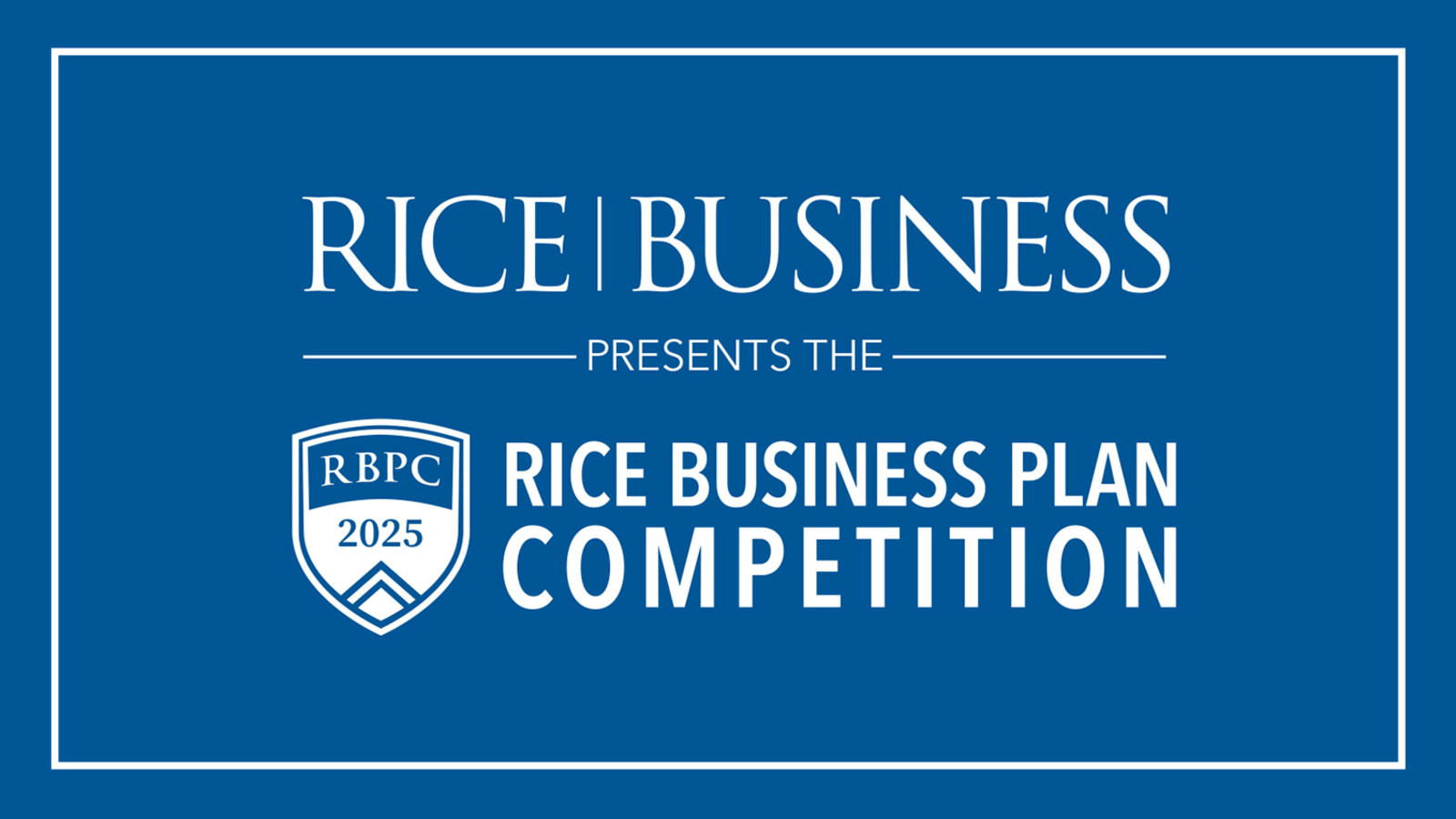
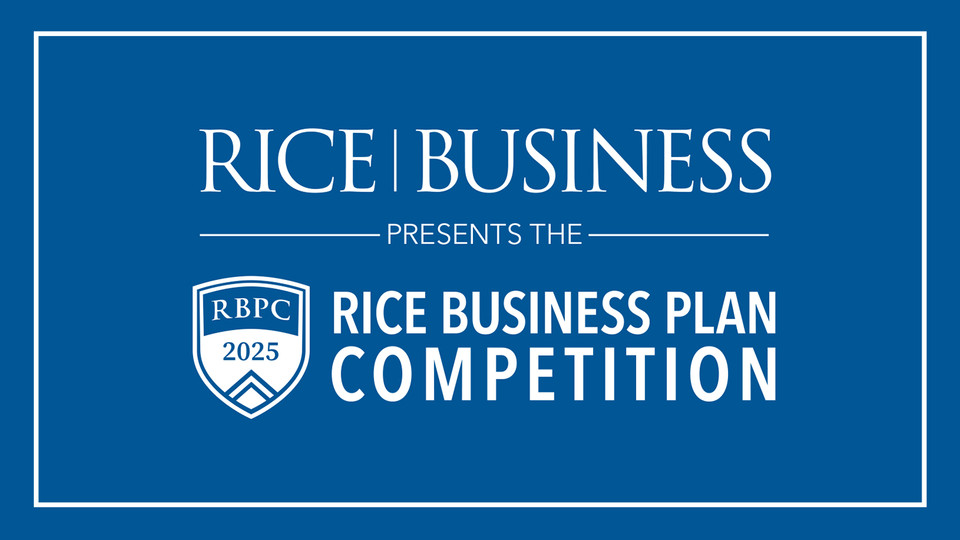
The 25th annual event in April will be hosted by Rice Alliance for Technology and Entrepreneurship
In honor of the Rice Business Plan Competition’s (RBPC) 25th year, Rice University’s Jones Graduate School of Business and the Rice Alliance for Technology and Entrepreneurship announced today that Rice Business will be the presenting sponsor at this year’s event.
The world’s largest and richest intercollegiate student startup competition, the RBPC is hosted and organized every spring by the Rice Alliance. Each year, the RBPC brings together the best student ventures from top universities across the world to compete for more than $1 million in prizes in front of more than 350 venture capital, angel and corporate investors as well as members of the Houston business community.
“Supporting the RBPC reflects our deep commitment to entrepreneurship and innovation,” said Dean Peter Rodriguez. “Houston is a pro-business hub and a hotbed for breakthroughs in energy, health care and technology. As Rice Business celebrates 25 years of the RBPC, we are proud to strengthen our role in shaping future leaders who will drive progress in these vital industries.”
The RBPC has played an important role in the business school’s reputation for entrepreneurship. Rice Business has earned the No. 1 spot for graduate entrepreneurship programs by Entrepreneur magazine and The Princeton Review for six years in a row and sits at No. 8 on the U.S. News & World Report list of top MBA schools for entrepreneurship. The university’s entrepreneurial ecosystem features a collaborative culture, a willing network of mentors, paths to funding and multiple competitions. The ecosystem also combines academic courses and cocurricular programs led by the Liu Idea Lab for Innovation and Entrepreneurship and regional, national and cocurricular programs led by the Rice Alliance.
“The RBPC offers real-world opportunities to learn what’s required to successfully launch a new business,” said Brad Burke, associate vice president for industry and new ventures at Rice’s Office of Innovation and executive director of Rice Alliance. “But to me, the greatest part of the RBPC is the mentoring students receive from the experienced investors and entrepreneurs at the competition. It’s remarkable to see the success of these ventures after the RBPC; RBPC alumni have raised more than $6.1 billion in funding. Many founders feel their success was greatly accelerated by the mentors and investors they met at Rice.”
Rice Business, which celebrated its 50th anniversary last year, has one of the leading MBA programs in the country with an entrepreneurship specialization, and the school has multiple programs and accelerators that provide guidance and support needed to launch and grow businesses.
Since its inception, the RBPC has grown from nine teams competing for $10,000 in prize money in 2001 to 42 teams from around the world competing for more $1 million in cash, investment and in-kind prizes. Over two decades, 826 teams have raised more than $6.1 billion in capital with 59 successful exits.
You May Also Like
Emerging focus on brain health among several Rice researchers’ expertise
Rice University is a hub of cutting-edge, multidisciplinary research on the brain. In addition to a critical mass of researchers in the field, Rice is home to entities dedicated to collaborative clinical and scientific research on the brain:


Brain health is a key factor in workforce well-being and organizational success and carries a deep-seated impact on economic development. In growing recognition of the role of the human brain as foundational to economies around the globe — both in terms of the costs associated with brain disease and as individual and collective brain capital — the notion of “brain economy” has emerged as a topic of interest for organizations such as the World Economic Forum, the United Nations General Assembly, the World Health Assembly, G7, the Organisation for Economic Co-operation and Development, UNESCO, UNICEF, the European Commission and the UN Council of Parties.
Rice University is a hub of cutting-edge, multidisciplinary research on the brain. In addition to a critical mass of researchers in the field, Rice is home to entities dedicated to collaborative clinical and scientific research on the brain:
● The Rice Neuroengineering Initiative harnesses Rice’s world-class expertise in neuroscience, engineering and related fields like signal processing, biosciences and nanotechnology to explore neural function and interactions with the brain.
● The Center for Neural Systems Restauration (CNSR), a collaboration between Rice and Houston Methodist, is an interdisciplinary center for neuroscience research and medical treatment innovation designed to bring together scientists, clinicians, engineers and surgeons to tackle complex brain-related medical challenges like stroke recovery, mild traumatic brain injury detection, upper and lower limb mobility restoration, balance and biofeedback training.
● The Neuro-Policy Program at Rice’s Baker Institute for Public Policy leads an interdisciplinary approach to addressing brain health challenges and advancing economic opportunity. The program is at the forefront of pioneering data analysis, empirical research and policy application.
As employers, policymakers, health care providers, educators and other stakeholders continue to engage this topic, Rice experts are ready to offer their insight on scientific and biomedical advancements relevant to brain health.
Policy, leadership and the brain economy
● Harris Eyre is the Harry Z. Yan and Weiman Gao Senior Fellow in Brain Health at the Baker Institute, where he leads its Neuro-Policy Program. With a background in medicine, neuroscience and business, Eyre is an entrepreneur and scholar dedicated to fostering awareness, knowledge, skills, tools and leadership for the brain economy. He works closely with the McKinsey Health Institute and is a member of the Champion’s Cabinet of the Davos Alzheimer’s Collaborative and the Cancer Neuroscience Program at the University of Texas MD Anderson Cancer Center. He also is an adjunct with the University of California, San Francisco.
Brain science and technology
● Behnaam Aazhang is the J.S. Abercrombie Professor of Electrical and Computer Engineering and director of the Neuroengineering Initiative. Aazhang’s research interests are focused on developing noninvasive tools to interface with neurological systems that examine neuronal circuit connectivity through the study of processes such as learning, sleep, seizures and more. His work includes projects dedicated to the development of minimally and noninvasive real-time neuromodulation systems to mitigate disorders such as epilepsy, Parkinson’s disease, depression, obesity and mild traumatic brain injury.
● Valentin Dragoi’s work examines how networks of cortical neurons encode information and how this process influences behavioral decisions in real time using a combination of electrophysiological, behavioral and computational methods. Dragoi is a professor of electrical and computer engineering at Rice, the Rosemary and Daniel J. Harrison III Presidential Distinguished Chair in Neuroprosthetics at Houston Methodist and professor of neuroscience at Weill Cornell Medical College. He also serves as scientific director of the CNSR.
● Caleb Kemere, an associate professor of electrical and computer engineering and bioengineering at Rice, develops novel hardware and machine learning algorithms to understand how information is processed, stored and retrieved in vivo in the mammalian brain. In particular, a key area of Kemere’s focus is to understand how the activity of neural circuits during sleep and other offline periods helps to create stable, useful memories.
● Marcia O’Malley, Rice’s Thomas Michael Panos Family Professor in Mechanical Engineering, researches haptics and robotics with a focus on the design and control of wearable robotic devices for training and rehabilitation from injury such as a stroke. Forging new ways to leverage human-robot collaboration, O’Malley has led the development of robotic hardware and control systems for applications such as skill training in virtual reality; control of remote robots; communication; and movement assistance for workforce safety, dexterity and strength enhancement.
● Jacob Robinson is a professor of electrical and computer engineering and bioengineering at Rice and founder and CEO of Motif Neurotech, a startup focused on developing therapeutic brain-computer interface (BCI) technologies to measure and regulate mental and cognitive states beginning with treatment-resistant depression. Robinson’s research efforts inform the development of next-generation implantable BCIs with improved performance and reduced surgical risk.
● Jerzy Szablowski, assistant professor of bioengineering, works on technologies to noninvasively control and monitor specific brain circuits without wearable or implanted devices. His technologies include synthetic serum markers that can monitor gene expression in the brain with a simple blood test, designer vectors for noninvasive gene delivery to the brain and site-specific therapeutics that can control selected brain circuits to avoid side effects associated with current brain therapies.
Brain health in the workplace
● Margaret Beier, professor and department chair of psychological sciences, examines how motivational and situational components and traits such as cognitive ability and personality are related to intellectual development throughout the lifespan with a current focus on workplace aging and continuous employment. Beier also studies predictors of performance in achievement settings and achievement-related choices throughout the career lifespan.
● Rebecca Brossoit is an assistant professor of psychological sciences whose research examines the health, safety and well-being of working populations. Brossoit studies employee sleep, organizational strategies and interventions for improving employees’ lives at work and home and the impacts of the built and natural environment on employee well-being.

Creativity, innovation and organizational behavior
● Jing Zhou is deputy dean of academic affairs for the Jones Graduate School of Business and the Mary Gibbs Jones Professor of Management and Psychology. Her research interests are leading innovation; contextual and personal factors that facilitate or inhibit creativity and innovation; creativity receiving; consequences of creativity; cross-cultural differences in antecedents and consequences of creativity; and creativity in entrepreneurship.
To schedule an interview with any of Rice’s experts on brain-related topics, contact Silvia Cernea Clark, media relations specialist, at sc220@rice.edu, or Chris Stipes, executive director of news and media relations, at chris.stipes@rice.edu.
You May Also Like
How Rice MBAs Are Leading the Energy Transition
Our students don’t just learn about changes in the energy industry — they lead them. Together, we’ll transform your career in the energy capital of the world.

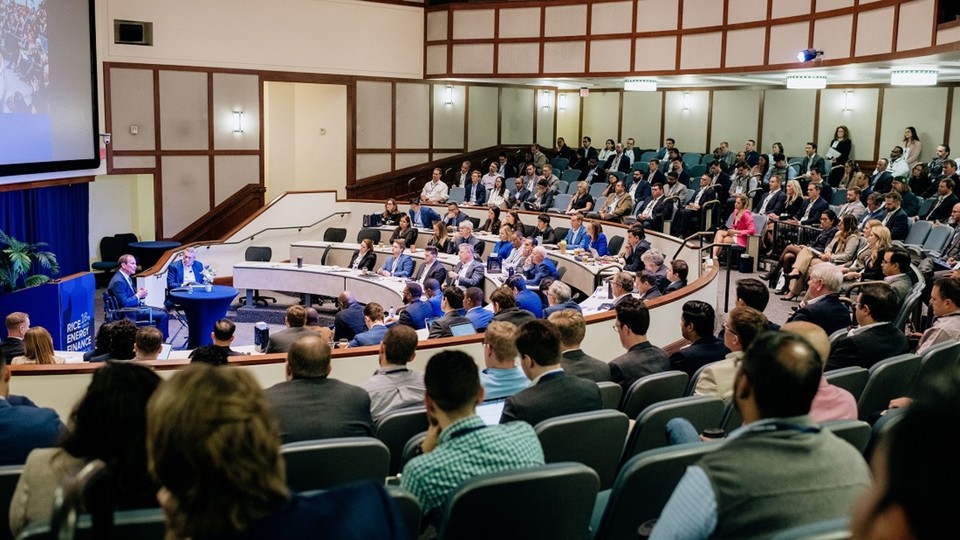
Updated from original post that was published on 1/9/2025.
Being in the heart of Houston — the world’s energy capital — we’re more than a business school. We’re a community. We explore breakthroughs, tackle emerging trends and connect with the brightest minds in energy. Our students aren’t just here to learn; they’re here to shape what’s next.
Through student-led conferences, competitions and Houston’s unparalleled energy events, Rice Business students gain hands-on experience and form lifelong connections. Whether you’re looking to advance in energy or make a bold pivot, you’ll be right where the action is.
How Rice MBAs Are Leading the Transition
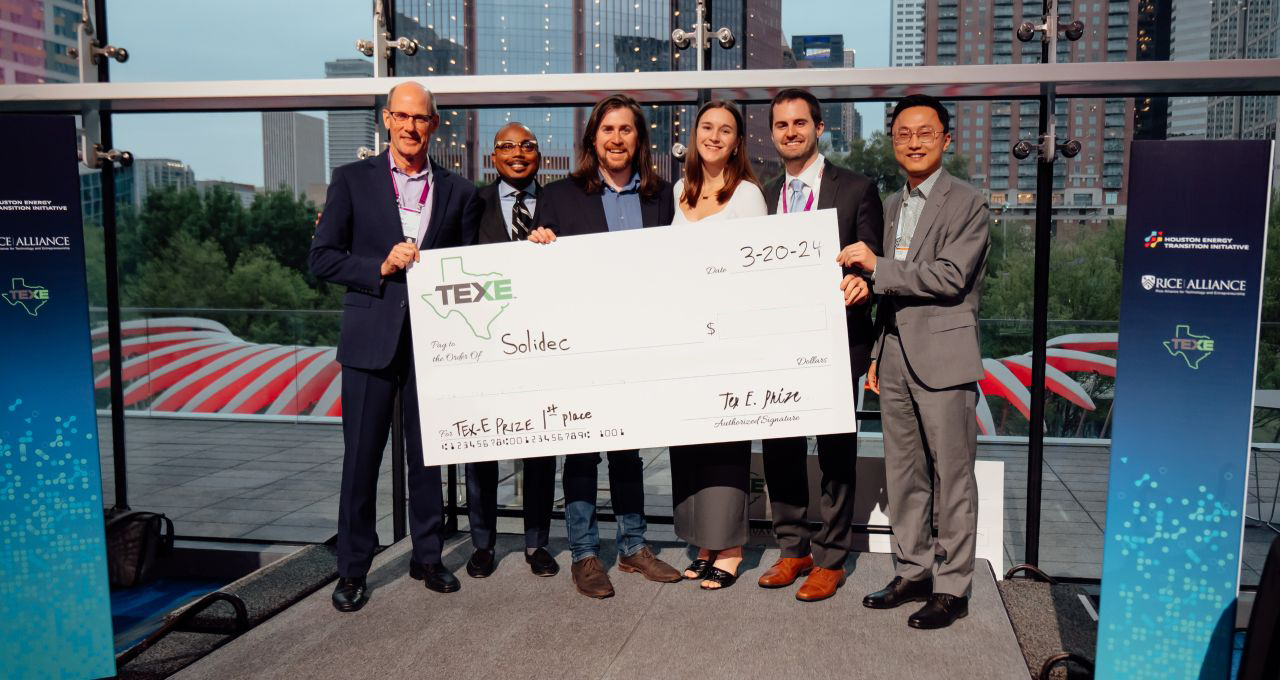
Our MBAs are passionate about change — and at Rice Business, change starts together. With peers, faculty and industry leaders by your side, you’ll have the chance to drive innovation and make an impact that lasts.
From hosting dynamic conferences to solving real-world competition challenges, here are a few ways Rice Business is helping students lead in the energy transition:
- Rice Energy Finance Summit (REFS): Attend our annual student-led conference and explore big ideas with industry leaders tackling global energy challenges.
- Rice Cleantech Innovation Competition (RCIC): Compete for $27,500 in prizes, solve real problems and connect with cleantech innovators.
- Renewable Energy Leadership Conference: Join clean energy leaders in reimagining the U.S. electric grid.
- Energy Tech Venture Forum: Partner with investors and startups to shape the future of energy.
- Rice Business Plan Competition (RBPC): Pitch your ideas on the world’s largest and richest student startup stage.
At Rice Business, the opportunities are endless. Together, we’ll pave the way for an energy future that’s smarter, greener and brighter.
Interested in Rice Business?
Powering the City
Houston isn’t just the energy capital — it’s a hub for innovation. With world-class conferences and over 270 cleantech and climate-tech startups, there’s no better place to lead the energy transition. At Rice Business, you’ll be at the center of it all.
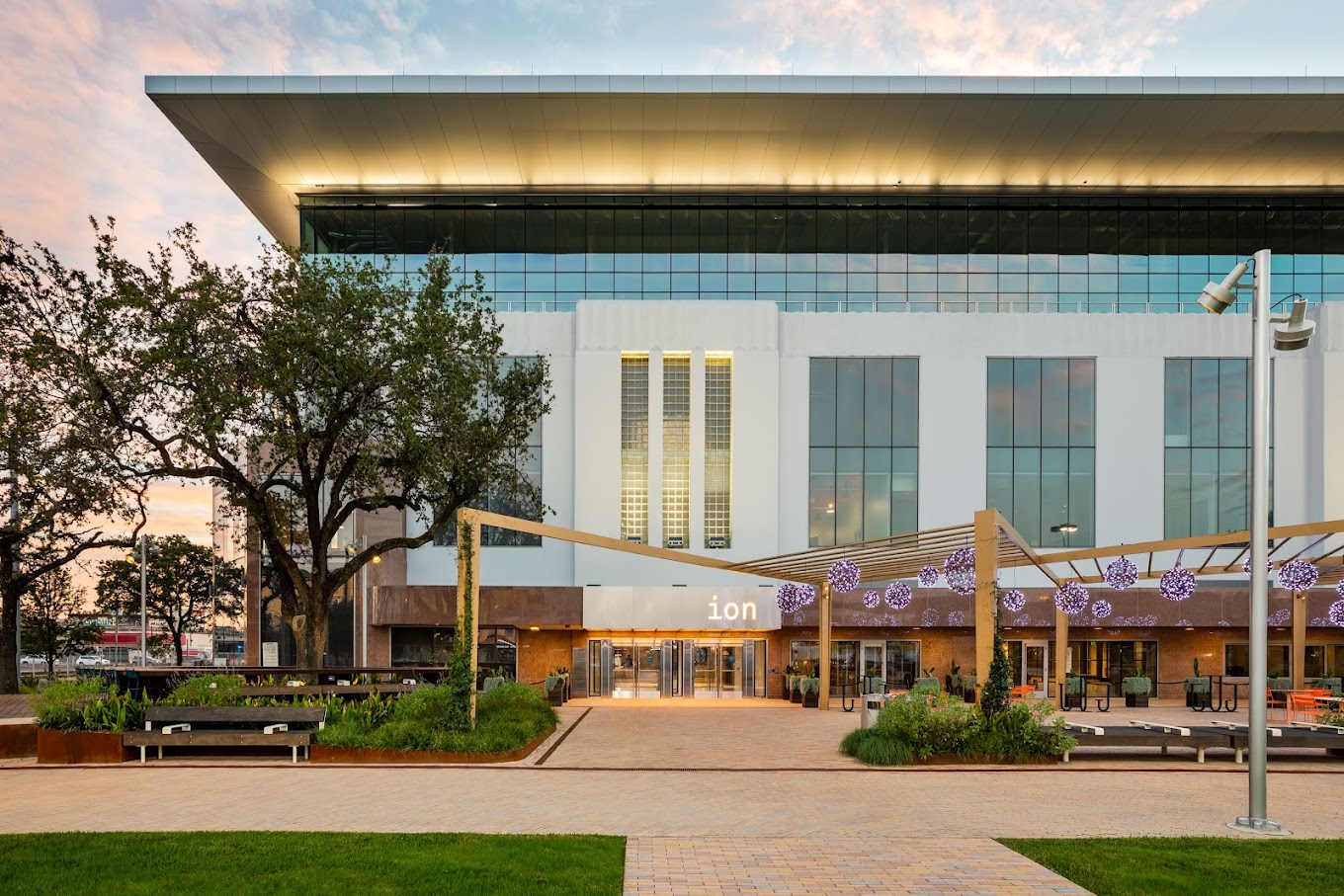
Here are just a few events that put you right where the action happens:
- Offshore Technology Conference (OTC): Connect with global innovators at one of the world’s largest energy events.
- CERAWeek by S&P Global: Be part of game-changing conversations on energy and climate.
- North American Prospect Expo (NAPE) Summit: Explore cutting-edge trends in oil, gas and renewables, including the Energy Innovation Case Competition.
Beyond conferences, Houston’s Ion District offers hands-on opportunities to collaborate and create. At Rice Business, you’ll be immersed in a vibrant community of thinkers and doers — building your network and transforming your future.
The Rice Business Impact
At Rice Business, we believe in building the future together. Through cutting-edge courses, hands-on projects and invaluable networking, we empower students to thrive in the evolving energy landscape.
Our energy specialization includes standout courses like Renewables and the Energy Transition Lab, where students collaborate with organizations in government, academia, nonprofits or industry on energy projects that match their interests. These electives allow students to further collaborate on real-world projects with industry leaders.
Rice Business alums are proof of the power of our community:
- Nicole Grimes ’20 moved to Houston from Florida, started in financial services, and now works as senior advisor for corporate brand strategy and advertising at ExxonMobil. “I had always loved commercial digital art, but the energy sector really fascinated me,” she says. “Now, I’m motivated and inspired by the challenges of the energy transition. I finally understand what purpose is.”
- Phoebe Wang ’13, a 2022 C3E Business Award winner, credits her Rice MBA for helping her advance her career. “I grew up in Asia, and pollution was such an important issue,” says Wang. “I started my career in material science engineering, so now it's kind of coming full circle that I'm looking at investments in climate tech. I think the Rice MBA let me, kind of, leapfrog in my career.”
Learn more about Phoebe's journey on our podcast, Owl Have You Know.
Energy is the top industry for our graduates. In 2024 alone:
- 18.2% of Full-Time Rice MBA grads started careers in energy.
- Full-Time MBA grads are earning 80% more in their post-MBA energy roles compared to the average salary pre-MBA.
- 29% of Professional MBA grads joined energy roles.
Between Houston’s thriving energy conferences, our alumni connections and student-led organizations, you’ll gain everything you need to help lead the energy transition.



